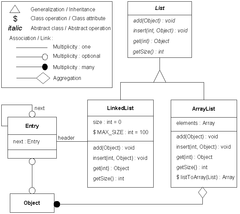

The object-modeling technique (OMT) is an object modeling approach for software modeling and designing. It was developed around 1991 by Rumbaugh, Blaha, Premerlani, Eddy and Lorensen as a method to develop object-oriented systems and to support object-oriented programming. OMT describes object model or static structure of the system.
OMT was developed as an approach to software development. The purposes of modeling according to Rumbaugh are:
- testing physical entities before building them (simulation),
- communication with customers,
- visualization (alternative presentation of information), and
- reduction of complexity.
OMT has proposed three main types of models:
- Object model: The object model represents the static and most stable phenomena in the modeled domain. Main concepts are classes and associations with attributes and operations. Aggregation and generalization (with multiple inheritance) are predefined relationships.
- Dynamic model: The dynamic model represents a state/transition view on the model. Main concepts are states, transitions between states, and events to trigger transitions. Actions can be modeled as occurring within states. Generalization and aggregation (concurrency) are predefined relationships.
- Functional model: The functional model handles the process perspective of the model, corresponding roughly to data flow diagrams. Main concepts are process, data store, data flow, and actors.
OMT is a predecessor of the Unified Modeling Language (UML). Many OMT modeling elements are common to UML.
Functional Model in OMT: In brief, a functional model in OMT defines the function of the whole internal processes in a model with the help of "Data Flow Diagrams (DFDs)". It details how processes are performed independently.
References
- Rumbaugh et al. (1991:15)
- ^ Terje Totland (1997). 5.2.7 Object Modeling Technique (OMT) Thesis, Norwegian University of Science and Technology (NTNU), Trondheim.
- (Rumbaugh et al.,1991:21)
Further reading
- James Rumbaugh, Michael Blaha, William Premerlani, Frederick Eddy, William Lorensen (1994). Object-Oriented Modeling and Design. Prentice Hall. ISBN 0-13-629841-9
- Terry Quatrani, Michael Jesse Chonoles (1996). Succeeding With the Booch and OMT Methods: A Practical Approach. Addison Wesley. ISBN 978-0-8053-2279-8
External links
The model is defined by the organization’s vision, mission, and values, as well as sets of boundaries for the organization—what products or services it will deliver, what customers or markets it will target, and what supply and delivery channels it will use. While the business model includes high-level strategies and tactical direction for how the organization will implement the model, it also includes the annual goals that set the specific steps the organization intends to undertake in the next year and the measures for their expected accomplishment. Each of these is likely to be part of internal documentation that is available to the internal auditor.
| [REDACTED] | This Unified Modeling Language article is a stub. You can help Misplaced Pages by expanding it. |